Face-Off: Diablo 3
PC veteran Blizzard rolls the dice on PS3 and Xbox 360.
| Xbox 360 | PlayStation 3 | PC | |
|---|---|---|---|
| Disc Size | 6.9GB | 12.8GB | 12.5GB (download) |
| Install | 6.9GB | - | 12.5GB (mandatory) |
| Surround Support | Dolby Digital | Dolby Digital, DTS, 5.1 LPCM, 7.1 LPCM | Set-up Dependant |
There's more than one elephant in the room when it comes to the console release of Diablo 3 - Blizzard's first venture from PC since developing Lost Vikings 2 back in 1997. The main one, in a surprise turn, is to question why it took so long, given just how comfortable the pairing is between the series' hack 'n' slash gameplay and the direct character controls possible with the PS3 and 360 pads. Skill and equipment menus are mapped to a convenient rotary dial, while combat is spiced up via a rolling dodge mechanic that feels very natural. Blizzard's custom engine also arrives in full force on both current-gen platforms, but with a PS4 release inbound for 2014, are there any drawbacks here which might warrant holding out for a next-gen version?
The first nail to knock on the head is the comparison with PC. While Diablo 3 is likely being used as a test-bed for future controller-based games, the studio is taking the opportunity to add - and perhaps more importantly, remove - certain features to make for a more compelling experience on console. For starters, gone is the "always online" DRM that beset the PC version, which continues to add latency after each click for even solo adventurers. In a call-back to the series' roots, console owners can now go entirely offline and play co-op alongside up to four people via a LAN, or otherwise by sharing the same screen with four gamepads on the go. The system is simple but effective, allowing players to drop in and out seamlessly, and represents the biggest plus-point in our estimation over the original PC release.
Also gone is the Auction House, an experiment on Blizzard's part to draw loot trade on the PC version away from eBay and contain it within its own eco-system. With the studio now admitting regret over the choice to follow this controversial path, the closed nature of Microsoft and Sony's platforms at least offers a way to mitigate the issue, and give a fresh start for a brand new audience.
Technically, the PC build is designed with DirectX 9 in mind to ensure broad compatibility, and the PS3 and 360 releases are underpinned by the very same in-house engine. Updated to the very latest patch v1.0.1 on all formats, the biggest mix-up on the visual front is the so-called "dynamic camera" which removes the faux-isometric perspective of the PC release in favour of a much lower angle on consoles. The style of this presentation comes down to personal preference, but when compared side-by-side with PC in our triple-format Diablo 3 comparison gallery, it's clear that the field of view (FOV) has become more restrictive in the process. A good chunk of the player's periphery is cut out as a result, making it easier for those embarking on four-way co-op missions to transport to the centre of the screen - should they veer too close to its vignetted edges.
"There's a resolution drop to 1120x584 on both consoles, but artwork and effects are very close to the PC version at high settings and the developer targets 60fps."
Alternative comparisons:
The game's resolution plays a part in this design choice too. With 1080p widely considered the standard on PC, that SKU can afford to frame a wider segment of the world without any sub-HD resolutions killing off minor details. But for both PS3 and 360 versions the reality is that the game runs at a native 1120x584, with what appears to be a pass of multi-sample anti-aliasing (MSAA). The nearer-field FOV helps to keep all characters and item drops perceptible despite this loss in fidelity - especially important once all chaos ensues with four players.
Reducing the framebuffer to just 70 per cent of the target 1280x720 isn't a deal-breaker in terms of image quality either, and in fact goes largely unnoticed when presenting the game's inherently muted colour scheme while dungeon-crawling. Jaggies are difficult to spot, and the only time stair-stepping artifacts crop up visibly is when faced with opened doorways spewing with light, or with alpha transparencies such as grass blades or fire. Either way, the multi-sample approach is a luxury that isn't afforded on the PC renderer - the sole option there being a post-process AA akin to FXAA, which blurs over texture details. It's rough in specific spots, yes - but by and large the PS3 and 360 push out a flattering take on the dark, fantastical world of Sanctuary.
Due to these differences in scale, and the lack of a FOV setting on PC, a direct pixel-perfect match with the console output isn't possible in image comparisons. However, the Hero Creation screen is a rare case where characters are kept to relative scale across all versions; this goes a long way to prove both texture map quality and model detail of each default class is identical to PC. Meanwhile, particle and alpha effects produced by wizards' spells during are also an absolute match for the original version. There's ultimately nothing to distinguish the PS3 and 360 renditions from one another in terms of environmental detail either once we spawn for the first time in New Tristram - these are hardly the most crisp floor textures you'll find, but they are fully intact from the PC version's high preset.
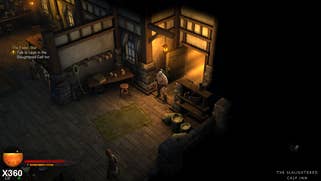
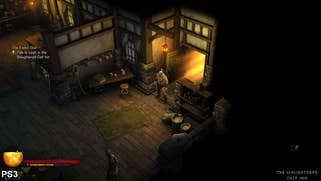
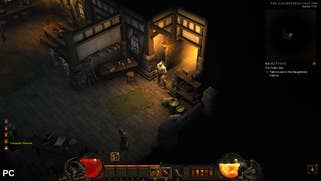
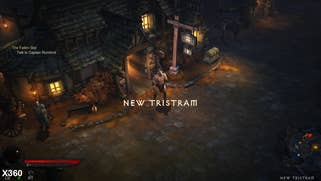

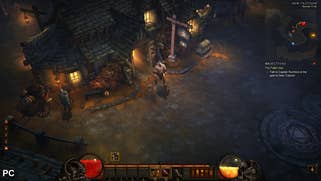
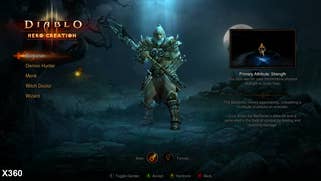

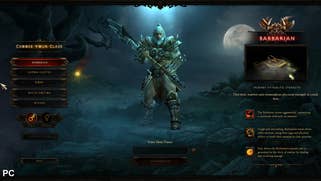
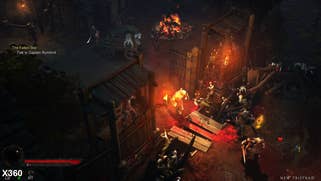
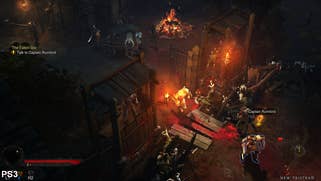

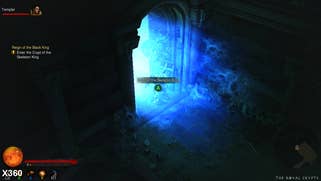
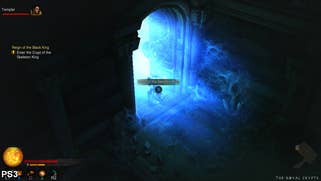



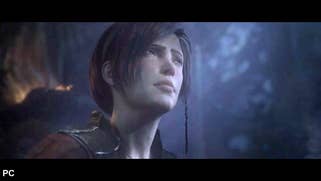
Diablo 3's shadow quality setting has always proved the most demanding toggle in the PC's settings menu, often making the difference between a solid 60fps or a stuttering experience when running at high quality with smoothing. Surprisingly, both PS3 and 360 releases opt for this more computationally taxing approach, with high resolution dynamic shadows stretching from our character's feet. These even benefit from the full smoothing treatment, but suffer from a slight flicker during movement that isn't present on the PC's very best setting - likely a customised approach, and one which fits between medium and high.
However, the one visual difference of note between the three versions of Diablo 3 is in the lighting, where the PS3 version neglects to apply directional lights from lamps on the ground texture maps below. They simply appear unlit by comparison to the 360 and PC, though this is only noticed while trekking around the initial New Tristram hub area - a minor detail that only becomes apparent with all versions side-by-side.
The last pillar of Diablo's visual design - and a benefit of its move to a fully 3D engine - is the use of cloth and object destruction physics. As far as the PC's concerned we're offered both high and low settings that determine whether a 75 per cent reduction in accuracy for colliding objects is enforced. The higher of the two settings is provided here; both 360 and PS3 boast an object fade-out time of precisely ten seconds for smashed urns, tables and chairs, which is precisely the same stopwatch figure as that of PC. The physics engine allows fabrics to flap, rag-doll corpses to blast into the sky, and tombstones to shatter beneath a crashing hammer slam - and with seemingly nothing pared back for these new releases. It's the complete package.
Diablo 3: performance analysis
With the exception of a nipped internal resolution, the delivery of Diablo 3 on current-gen platforms is very smooth indeed. What better news to top this off then, than the revelation that the game runs at a targeted 60fps on Sony and Microsoft's platforms. In a bid to match the sharp response of their PC counterpart, each console take full advantage of their 60Hz refreshes - although some shortcomings begin to surface when pressed.
To cut to the chase, the chief disappointment with Diablo 3 is undoubtedly the tearing, with both platforms caving in to full-screen tears whenever the screen clutters up with area-of-effect attacks and flying rag-doll enemies. Much like the aliasing issue, this can be difficult to catch by eye given the general gloom of Diablo's aesthetic early on. But even so, this manifests as an intrusive wobbling effect as we run uncontested through even simple woodland areas. Put into comparison, during our video test comprised of battling the 360 tears 24.1 per cent of its frames overall, while the PS3 turns in an average of 32.7 per cent torn frames during the very same scenarios.
"Both console offerings target a 60fps update with variable results - both have visible tearing, but of the two versions, it's Xbox 360 that is the clear performance winner."
The very first battle outside the New Tristram gates brings this to the fore quite visibly, and also drags the frame-rate down to the lowest point possible on either platform. Even with the absence of v-sync, the PS3 produces a sustained 40fps as the enemy horde rises from the outskirts of the town, generating an uneven sensation while moving our Barbarian character. The 360 fares much better here overall by bottoming out at 50fps with likewise tearing.
Fortunately, this is an exceptional case reserved for this opening section, plus some of the more extravagant boss battles such as the run-in with the Skeleton King. While overworld areas like the Old Ruins and Cemetery of the Forsaken play out with occasional dips to varying degrees on either platform, for the majority of the dungeon-crawling experience the game delivers on the 60fps promise with zero tearing.
Diablo 3: the Digital Foundry verdict
The console versions of Diablo 3 are top-drawer ports overall, and each version's suite of multiplayer options give them a noteworthy edge - even over the PC release. Besides allowing for four-player mayhem to unravel on one console, it's possible to play in a traditional LAN setup, or simply go online as per usual - all with a direct control system and a new roll mechanic that starts to feel inseparable from the experience within moments. The removal of the Auction House and generous tweaks to the loot system are welcome too, all combining to make this Diablo feel closer to the wild spirit of its predecessors, and certainly a more social experience.
On the technical scale, both the PS3 and 360 are running at the equivalent to the PC version's high settings for texture assets, physics and effects - with smoothed dynamic shadows almost a match for PC's highest preset. Quibbles with internal resolution and field of view aside, this is a pristinely presented take on a year-old game that targets 60fps on both platforms, and largely succeeds in nailing exactly that. There's very little between the two releases on the visual front, so the biggest differentiator is in terms of performance, where the 360 version dishes out the smoother frame-rate during boss battles and specific overworld areas. However, the prolific tearing on both platforms is something to consider, and if you're hoping for a fully v-synced version, the PS4 version due to next year will likely have the overhead to address this issue.
If you're at all tempted to play on Diablo 3 on console we'd urge jumping in now rather than waiting months for a next-gen version. While the 360 offers a performance advantage over PS3, the release for Sony's current platform remains impressive and brings about some unique benefits too. Ranked among them are the five exclusive in-game items, the subscription-free online play, and while it remains unannounced and completely unconfirmed so far, it wouldn't be outlandish to assume an option to transfer your hero to the upcoming PS4 version is in consideration at Blizzard - whereas no Xbox One version has been announced as of writing. But to live in the moment, the PS3 and 360 releases of Diablo 3 mark a hugely successful experiment for the studio, and we hope to see its other prized franchises make a similar jump once the next generation hits.



